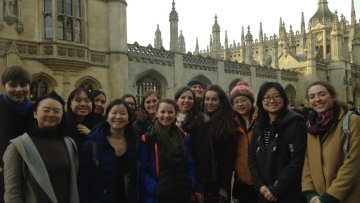People make a city. Each city is as unique as the combination of its inhabitants. Currently, cities are generally categorised by size, but research by Oxford Mathematicians Peter Grindrod and Tamsin Lee on the social networks of different cities shows that City A, which is twice the size of City B, may not necessarily be accurately represented as an amalgamation of two City Bs.
Oxford Cryptography Day
Abstract
We hope to bring together all Oxford researchers interested in Cryptography, in Quantum Computing and in the interactions between the two.
Please register at: http://oxford-cryptography-day.eventbrite.co.uk
11:00
27% of mathematics undergraduates in Oxford are female. We would like the figure to be higher and we are putting a lot of resource in to making it so. However, it is also important that current female and non-binary Oxford mathematicians feel they have time and space to discuss and share experiences that may be specific to them.
Manifolds with odd Euler characteristic
Abstract
Orientable manifolds can only have an odd Euler characteristic in dimensions divisible by 4. I will prove the analogous result for spin and string manifolds, where the dimension can only be a multiple of 8 and 16 respectively. The talk will require very little background. I'll go over the definition of spin and string structures, discuss cohomology operations and Poincare duality.
15:00
More Efficient Structure-Preserving Signatures: Or Bypassing the Lower Bounds
Abstract
Structure-preserving signatures are an important cryptographic primitive that is useful for the design of modular cryptographic protocols. In this work, we show how to bypass most of the existing lower bounds in the most efficient Type-III bilinear group setting. We formally define a new variant of structure-preserving signatures in the Type-III setting and present a number of fully secure schemes with signatures half the size of existing ones. We also give different constructions including constructions of optimal one-time signatures. In addition, we prove lower bounds and provide some impossibility results for the variant we define. Finally, we show some applications of the new constructions.
Dividends, capital injections and discrete observation effects in risk theory
Abstract
In the context of surplus models of insurance risk theory,
some rather surprising and simple identities are presented. This
includes an
identity relating level crossing probabilities of continuous-time models
under (randomized) discrete and continuous observations, as well as
reflection identities relating dividend payments and capital injections.
Applications as well as extensions to more general underlying processes are
discussed.



